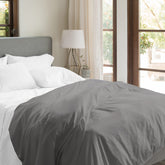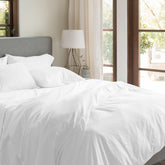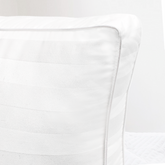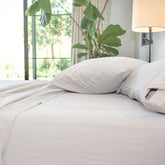If you’re looking for an inexpensive yet impactful way to completely change your living environment, just open up a can of paint! Whether you’re just focusing on a small room or are looking to switch up the style of your entire home, paint has the amazing ability to transform your space completely. A change of hue can make a space one of calm and tranquility or make a bold and powerful statement.
However, even though we love the magic power of paint, we also know how easy it is to get overwhelmed when trying to select just the right interior paint color. Here are few of our top tips to help make the whole process just a little easier and smoother for you!
Consider the mood you want to create
The first thing to do when selecting a color for a room is to consider what mood you want to create for the space. In other words, what do you want people to feel or experience when they enter the room? For example, if you’re painting a bedroom, do you want it to feel restful and soothing? Or perhaps your desire is to create a space that feels more dramatic, luxe, and intimate? It’s important to consider these intended moods and feelings so that you can keep them in mind as you look for the perfect color to match.
This is where the psychology of color comes into play. Research has shown that color can have a major impact on human mood and behavior. For example, blues and greens tend to be calming while red can signal an increase in appetite and energy. Yellow communicates happiness while pink has been shown to boost creativity.
When it comes to interior paint colors, soft, cool shades and neutrals usually create a quieter feeling, while stronger colors can bring drama to a room. In a bedroom, I always suggest painting the walls a beautiful shade of ivory, soft blue, or even lavender. These are all really calming colors that will help to create a better environment for sleep. After all, creating the best sleep environment should be one of your primary goals for any bedroom!
The same is true for painting kids’ rooms. Kids often want to have a say in how their room looks. While it’s fine to let them have some input on how they want to personalize the look of the room, you also need to be careful not to overstimulate them with bright colors. While some energy in a kids’ room is good, too many bright colors can be too stimulating for some children and can actually lead to restlessness and irritability. I think we can all agree that this isn’t ideal for kids – or their sleep-deprived parents!
Take lighting into account
You’d probably be surprised at how dramatically different paint can look in different lighting situations! For example:
- Natural daylight shows the truest version of a color
- Incandescent lighting will bring out warm tones and yellows
- Fluorescent lighting casts a sharp blue tone
Because of this, a strong color might be too bright and overpowering when used on all walls or next to a large window, but it may be perfect when used as an accent wall that only receives indirect light.
The best way to check how light affects paint is to start with the light boxes that most paint stores have and use them to look at swatches under different types of light. Ideally, however, you should also check the paint in the room itself. Pick up the largest swatches they have at the store or get sample-size testers and paint them on to boards. Place them in different parts of the room and check them at different times of day. See how they look in all lighting conditions before you make a final decision.
Explore different paint finishes
Another factor that can make a big difference to how a paint looks is finish. The same color used on walls and trims can have a completely different look when applied in different finishes. For example, you could keep wall and trim colors the same, but use an eggshell finish on walls and a satin or semi-gloss on the trim. This way, the color will appear slightly different on each surface, with a more nuanced, textured result. It’s a great way to create a cohesive look in rooms that have a lot of windows and doors, but not many large walls.
Use transitions to create flow
When selecting interior paint colors, don’t forget about the transition between one room and another. You want to create flow throughout your home, which will give the illusion of a larger, open space and can also help to create a relaxing feeling. Of course, that doesn’t mean you can’t use bold colors if that’s your style! However, you’ll want to complement the adjoining space with a contrasting color or one that is a shade or two lighter than your darkest color. Let the paint chips (and a color wheel) be your guide. One top tip is to consider using the lightest and darkest shades on a paint chip next to each other, as this will help to create a smooth transition.
Pick your paint LAST
This may sound counterintuitive, but it’s best to pick your paint last! Trust me, it’s much easier to choose a paint color that works with key décor pieces than to try and find décor that matches your paint! You may end up painting yourself into a corner (pun fully intended!).
Instead of starting with the paint, begin by establishing which furniture, fabrics, and art you would like to include in the space. Then let these be your guide. Use an existing object, pattern or print as your point of reference. Choose a complementary color from a rug, drapery, or favorite piece of art that can be your inspiration for painting the room, once those pieces are already selected. That way, everything will not only be cohesive, but you’ll add a little extra focus to a piece that you already love.
The bottom line? Don’t let all those paint swatches intimidate you! Remember that while there may be many variations, there are only a limited number of colors in the spectrum. You can usually eliminate a few with no problem at all, and then focus on the ones you are drawn to. Don’t rush the process. Keep the above tips in mind the next time you hit the paint store and you’ll be picking the perfect interior paint just like a pro in no time!






